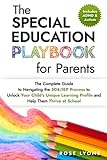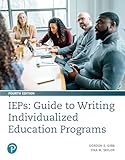How to Write IEP Goals & Objectives for IEPs
Did you know you’re supposed to be able to look at your child’s goals and KNOW for YOURSELF if your child is making progress? Do you know How to Write IEP Goals to do that? Can you look at your child’s current IEP and KNOW if he is making progress?
Schools often write vague, unmeasureable, goals based on a teacher’s opinion. The goals are neither tracked nor measured. If you know how to write IEP goals properly, your child won’t fall behind because nobody knows if he’s REALLY making progress or not.
A “Goal” is something a person is expected to achieve. In the case of your child’s IEP–it’s what YOU or the school expects your child to achieve.
Your Special Education Rights: What Your School District Isn't Telling You
$17.99 (as of 21 December 2025 22:34 GMT -05:00 - More infoProduct prices and availability are accurate as of the date/time indicated and are subject to change. Any price and availability information displayed on [relevant Amazon Site(s), as applicable] at the time of purchase will apply to the purchase of this product.)An “Objective” is defined as: The goal intended to be attained (and which is believed to be attainable); undistorted by emotion or personal bias; based on observable phenomena; emphasizing or expressing things as perceived without distortion of personal feelings or interpretation (WordNet Dictionary @ hyperdictionary.com).
Did you register that definition fully??
An objective in your child’s IEP is an attainable element of a goal. The objective is factual information without personal perception, distortion, and without biased interpretation. MANY IEP goals are not written to be objective nor measurable.
How to Write IEP Goals to Meet Measureable Criteria
In order to know if your child is making adequate progress in his education, his IEP goals must be objectively measurable.
Teacher observation and classroom grades are not valid forms of measurement. They are often biased. Observation and classroom grades have been designated as inappropriate measures of progress by the courts. That’s not to say teachers can’t “observe” success. However they must track progress through data tracking sheets. Physically writing down observations helps document progress objectively rather than subjectively “supposing” a child has met their goals.
Objective measurements are based upon standardized testing for specific skills or through ongoing data collection of appropriate data. Data collection is preferable as it will show a trend over time. It doesn’t rely on performance at a single point in time (when the child may be having an exceptionally good or exceptionally bad day). Objective measures should be “observable” by anyone at any time.
You might find it beneficial to read a reference book (or two) about how to write IEP goals. You can browse available books through this special link pointing to Books about IEPs. Many of these books can be checked out at your local library. It will help you know what types of books are available to help you understand IEPs in more depth.
Continue through this how to write IEP goals Unit to become FULLY Knowledgeable about setting goals and monitoring your child’s progress..









